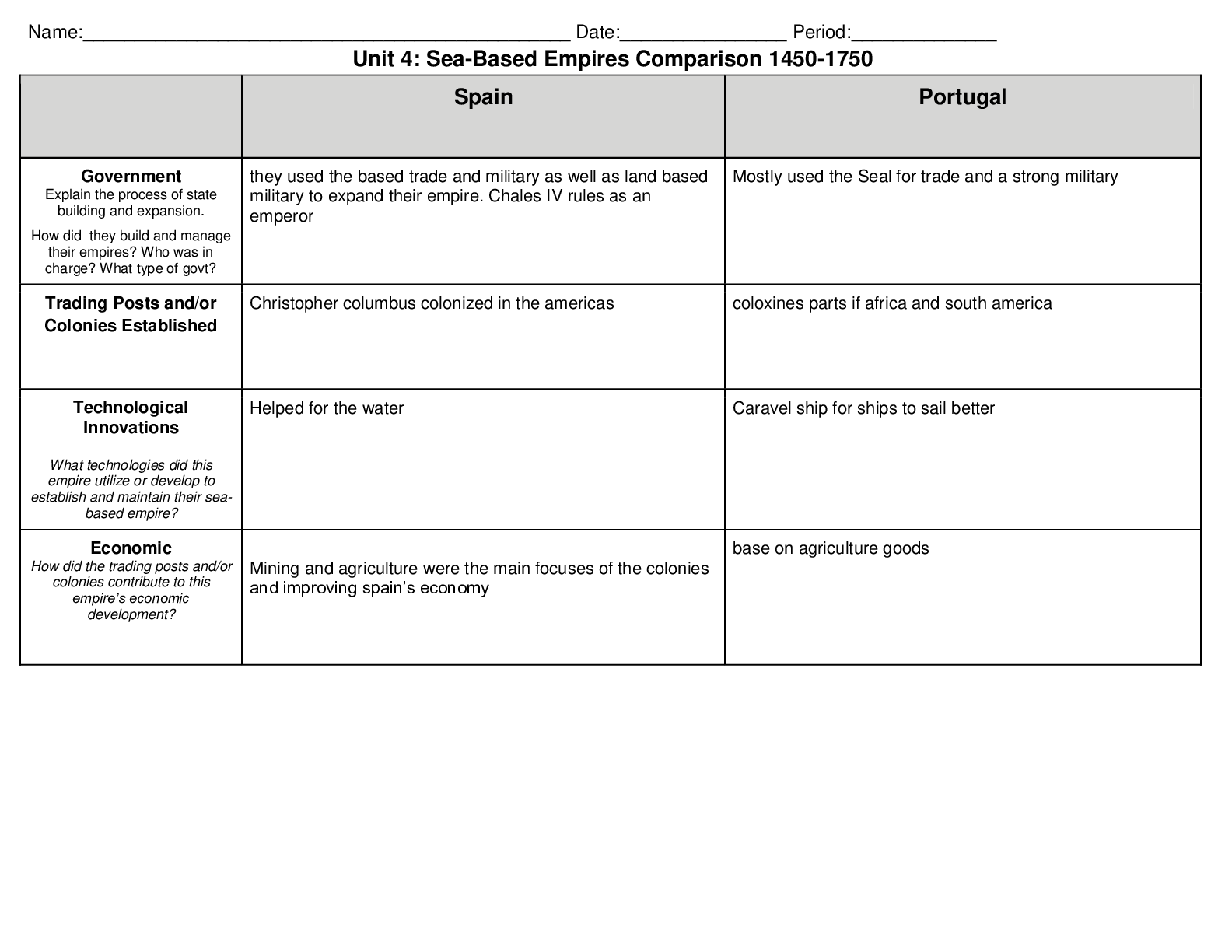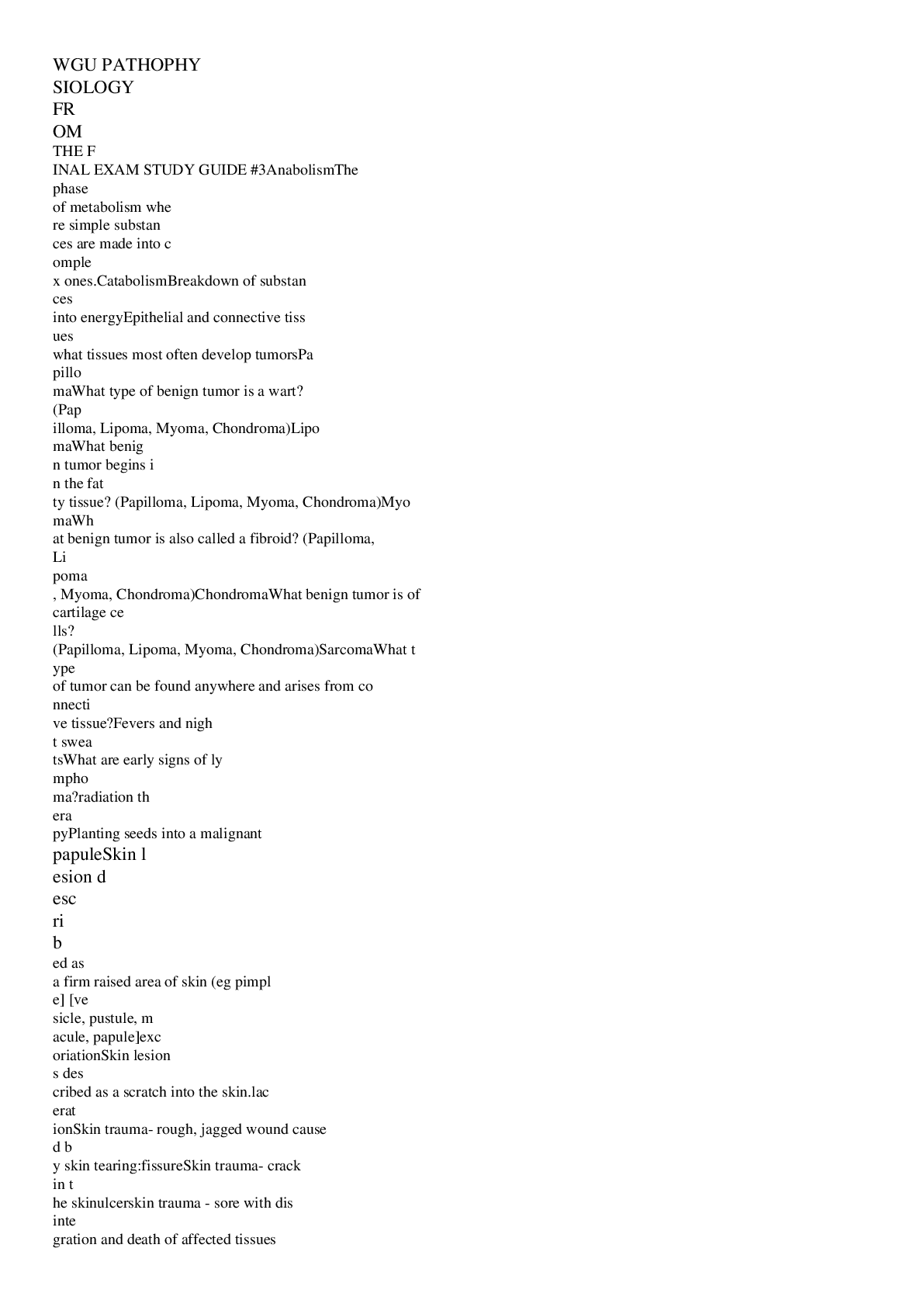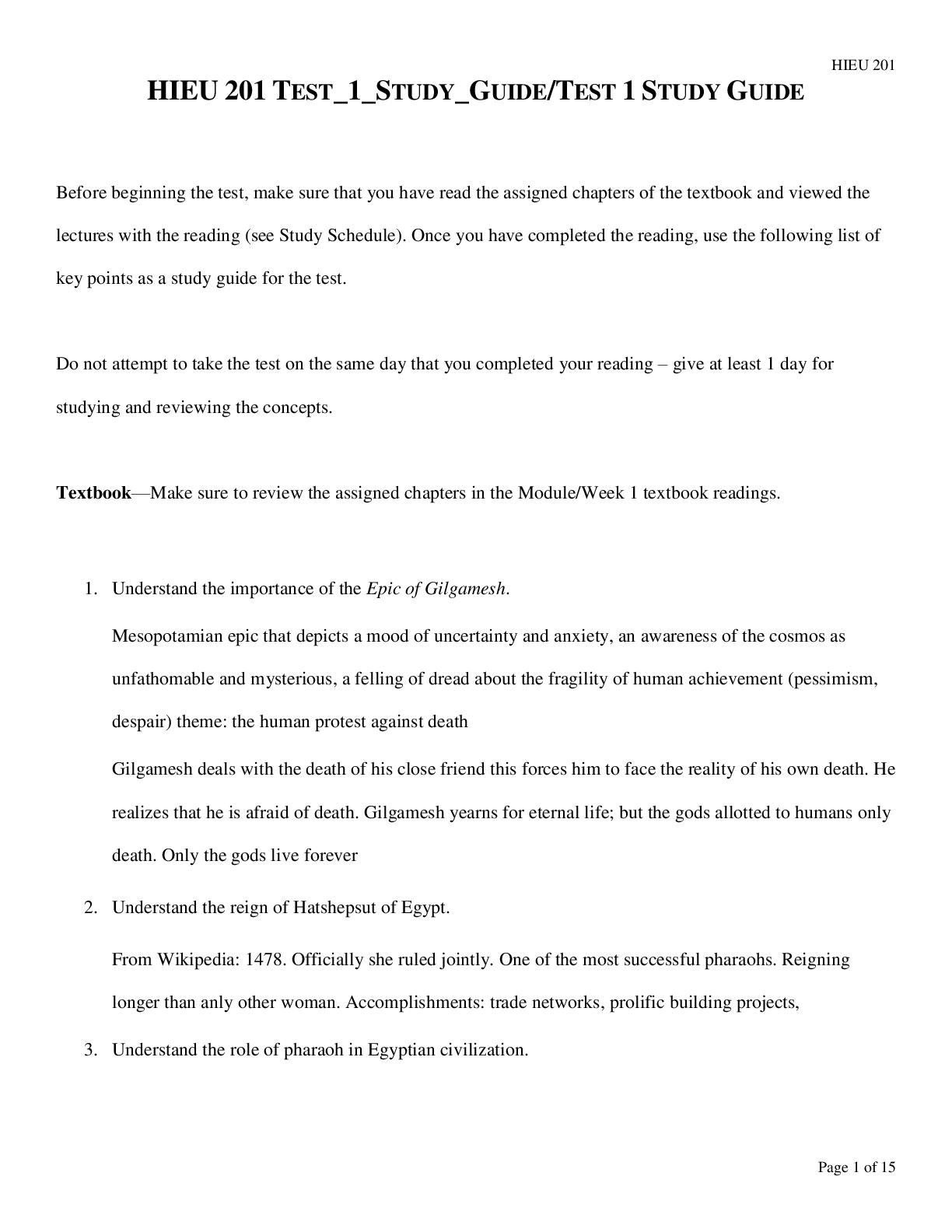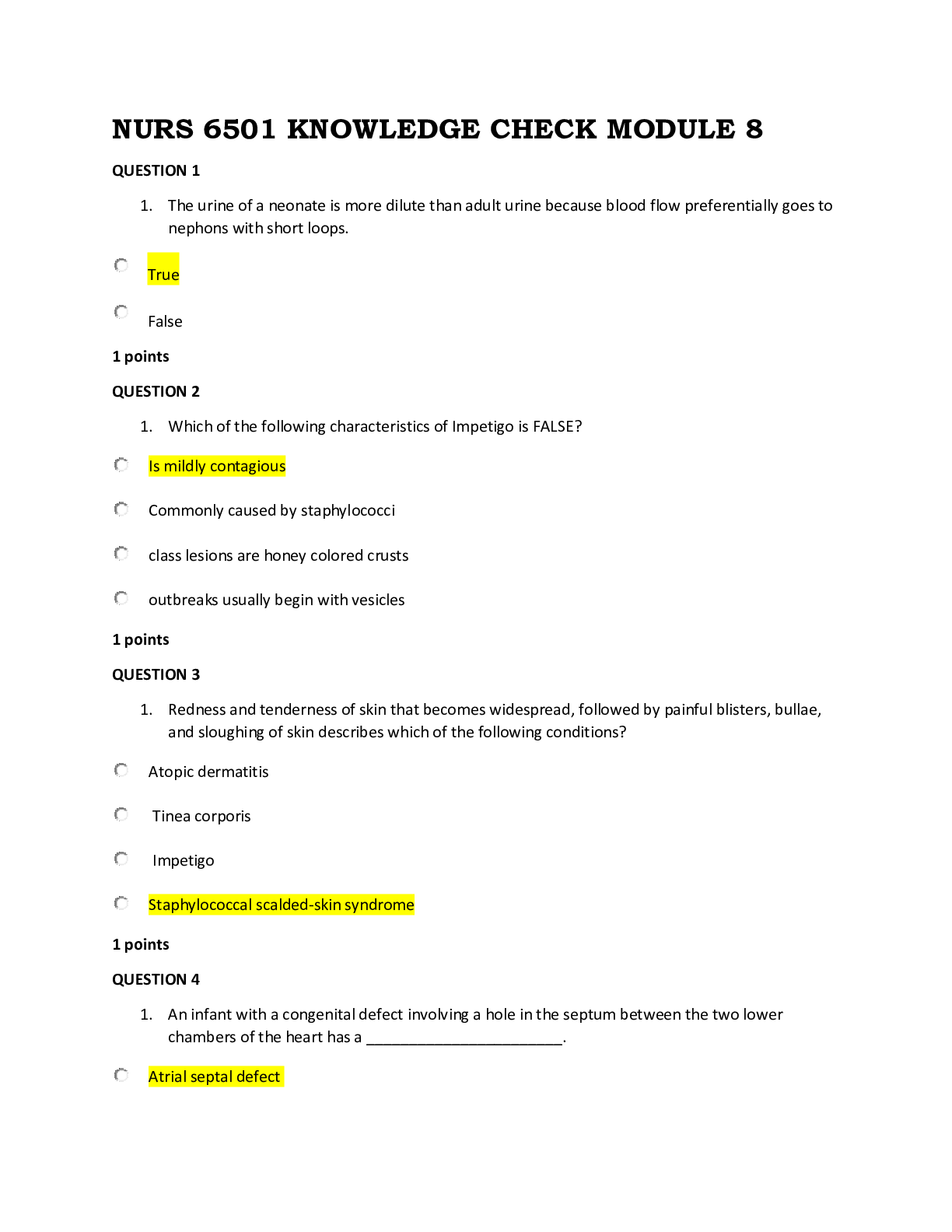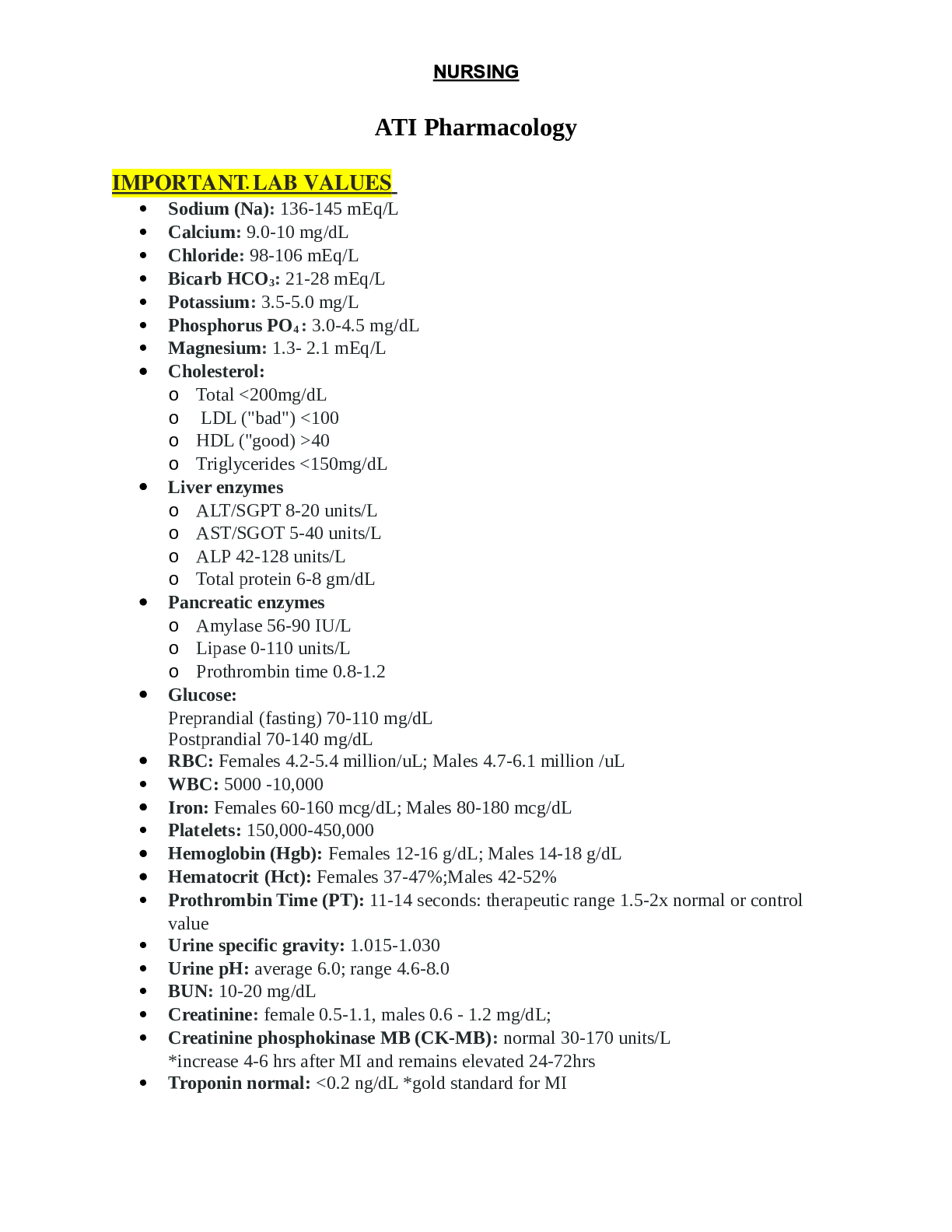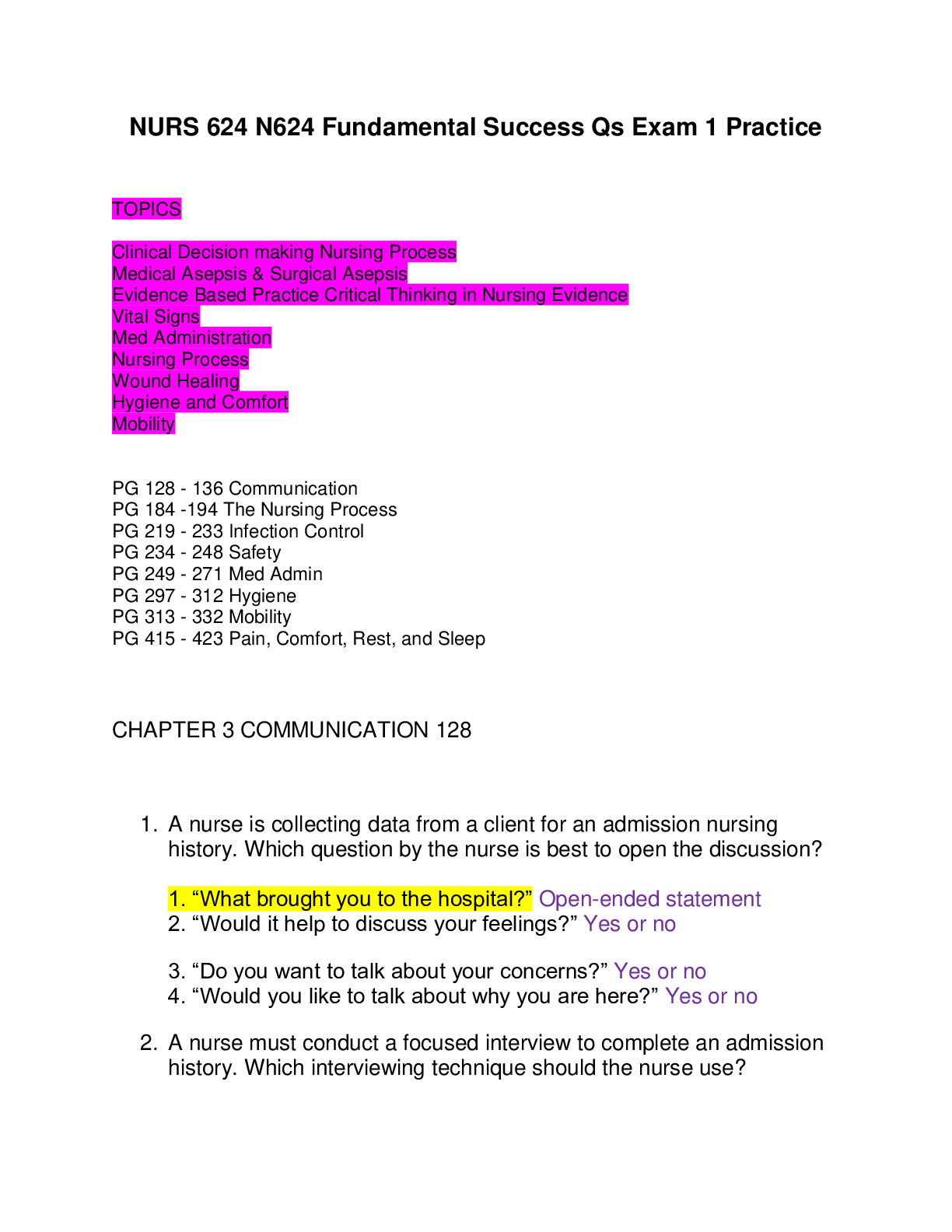Economics > STUDY GUIDE > MGMT 310 AMGMT Exam 1 Study Guide (All)
MGMT 310 AMGMT Exam 1 Study Guide
Document Content and Description Below
MGMT 310A MGMT 310 AMGMT Exam 1 Study Guide Chapter 1: What is Organizational Behavior? What do managers do? – Managers get things done through other people, make decisions, allocate resources... , direct activities. They also function through ORGANIZATION a consciously coordinated social unit of 2 or more people that functions on a continuous basis to reach a common goal or goals. Organizational Behavior: focuses on developing an understanding of how to manage individuals and groups in order to achieve desired objectives in organizations Management Functions, Skills, and Roles: 1. Functions A- Planning: Defining goals, establishing strategy, developing plans to coordinate activities B- Organizing: Determining what tasks are to be done, who does them, how they are grouped, who reports to whom, and where decisions are to be made C- Leading: Motivating subordinates, directing others, selecting the most effective communication channels, resolving conflicts. D- Controlling: Monitoring all activities to ensure everything is being done as planned, stopping deviations 2. Skills: Technical Skills: the abilitiy to apply specialized knowledge or expertise Human Skills: the ability to work with, understand, and motivate other people, both individually and in groups Conceptual Skills: the mental ability to analyze and diagnose complex situations 3. Roles Figurehead: symbolic head; required to perform a number of routine duties of a legal or social nature Leadership: responsibility for the motivation and direction of employees Liaison: maintains a network of outside contacts who provide favors and information Primary levels of Analysis Independent VS Dependent Variables – You manipulate an independent variable to determine a response from a dependent variable (EXAMPLE: IV: Advertising expenses DV: Sales) 1. Independent Variable: the presumed cause of some change in a dependent variable (CAUSE) 2. Dependent Variable: a response that is affected by an independent variable (EFFECT) Effective VS Efficient: Together, they constitute the performance measure known as PRODUCTIVITY. 1. Effectiveness: Achievement of goals 2. Efficiency: The ratio of effective output to input required to achieve it Random Assignment: a experimental technique where subjects are subjected to random treatment assignment, the logic being that the differences between groups will be the result of the independent variable as opposed to the result of the characteristics of the individual in the group. Know/understand these concepts: Turnover: Voluntary and involuntary withdrawal from an organization (Quitting/Getting Fired) *essentially a high turnover rate means that employees are constantly being replaced. If they are competent employees, this is likely an effect of poor management. It costs a lot to replace employees. Absenteeism: The failure to show up to work, every absent employee is a huge cost to employers Productivity: A performance measure comprised of effectiveness and efficiency Conceptual, Technical, Human Skills: [Outlined Above Under “Skills”] Manager: an organizational member who achieves goals through other people; they make decisions, allocate resources, and direct the activities of others to attain goals Organization: a consciously coordinated social unit, composed of two or more people, that functions on a relatively continuous basis to a achieve a common set of goals or goal Organizational Citizenship Behavior (OCB): Discretionary behavior that is not part of an employee’s formal job requirements but nonetheless promotes the effective functioning of the organization. A dependent variable of management, Organizational Behavior (OB) is concerned with OCB as a dependent variable. Forces of Change in Organizations Today: - Technological innovation (effects of technology on effective management) - Globalization (the integration of different nations and regions around the world in terms of commerce and communication) - Changing demographics and diversity (changing characteristics of populations) - employee empowerment (allocating power to employees so that they may help clients and consumers) Organizational Commitment: an employee’s psychological commitment to an organization 1. Affective Commitment: Emotional attachment to an organization and a belief in its values, for example, an animal lover that works at petsmart 2. Continuance Commitment: perceived economic value of staying with as opposed to leaving a company, for example, an employee committed to an employer due to the good pay that he needs to support his family 3. Normative Commitment: obligation to remain with an organization for ethical reason Chapter 2: Diversity in Organizations Know & understand the concepts of: Attitudes: evaluative statements or judgments concerning people, objects, and events. 1. Cognitive component: the part of attitude involving thought 2. Affective component: the emotional or feeling segment of an attitude 3. Behavioral component: and intention to behave a certain way toward someone or something Job Satisfaction: a positive feeling about one’s job resulting from evaluation of one of its characteristics 1. Job performance typically increases with job satisfaction 2. Job satisfaction typically increases OCB 3. Job satisfaction typically increases customer satisfaction 4. Job satisfaction decreases absenteeism 5. Job satisfaction decreases turnover 6. Job satisfaction decreases workplace deviance Levels of diversity Surface-level diversity: differences in easily perceived characteristics, such as gender, race, ethnicity, age, or disability, that do not necessarily reflect the ways people think or feel but that may activate certain assumptions Deep-level diversity: differences in values, personality, and work preferences that become progressively more important for determining similarity as people get to know one another better. Advantages of diversity o Multiple perspectives o Greater openness to new ideas o New markets o Increased creativity o Increased flexibility o Increased problem-solving skills Disadvantages of diversity o Ambiguity o Complexity o Confusion o Miscommunication o Difficulty in reaching agreement Generations at Work (how to treat them and work with them; strengths and weaknesses) Radio Babies (1900-1945) - Show respect - Demonstrate you are organised. - Emphasise long term goals and the history of a concept - Use your best grammar - Avoid Slang Baby Boomers (1946-1964) - Recognition is important; personal recognition is better - Take plenty of time to establish rapport. - Tie your concept to developmental opportunities. - Recognize relationships to mission and values of both organization and individual Generation X (1965-1980) - Show respect for time by being efficient - Be straightforward in approach. - Lead with the bottom line. - Use results-based language Millennial (1981-1990) - Use a collaborative approach. - Include peers in the meeting. - Be positive and give frequent feedback. - Show respect for achievements. - Use technology when possible. - Emphasize altruism. Forms of Intelligence Interpersonal intelligence: ability to understand other people: what motivates them, how they work, and how to work with them Intrapersonal intelligence: capacity to form an accurate model of oneself and to be able to use that model to operate effectively in life Emotional Intelligence (EI): How we do in life, manage feelings, get along with others, and are empathetic and motivated Goleman’s Emotional Intelligence Cognitive Dissonance: An uncomfortable condition of conflicting thoughts, such as “I’ve rejected something though it has some good characteristics” - An incompatibility between two or more components of attitudes or between behavior and attitudes (EXAMPLE: a person says he loves Japanese cars only, but once he gets a mustang, American cars suddenly aren’t so bad.) based on importance, influence, and rewards - Relationship Between Attitude and Behavior: people have a tendency to behave according to their attitudes, but may experience cognitive dissonance Voice Personality: The sum total of ways in which an individual reacts and interacts with others; measurable traits a person exhibits which influence how people see new situations and how they behave. Personality Determinants: Heredity and Environment Personality Theories Psychoanalytic theory: we are motivated by drives or instincts. Unconscious mind play large role. ‘Freudian slips’. Humanistic-existential theories: focus on total personality of the individual instead of on the separate behaviors that make up the personality. Downplay roles of environment and biology—focus on individual choice and personal responsibility. They emphasize striving for awareness and fulfillment of the human potential. Learning theories: see personality as a set of patterns of learned behaviors. Personalities differ because people have different experiences in childhood and throughout life. Personality based on simple learning principles. Personality Dimensions: 1.Risk Taking Propensity: risk averse= “like to play it safe” or risk seekers= “gamblers” 2.Proactive Personality: extent to which people take actions to influence their environments; look for opportunities, show initiative, take action, and persevere until change 3. Authoritarianism: people believe power and status should be clearly defined and that there should be a hierarchy of authority – authority should be concentrated in the hands of a few leaders and that this authority should be obeyed 4. Dogmatism: closed-minded, rigid belief systems and stick to their opinions 5. Locus of Control: refers to the degree to which individuals believe that the things that happen to them are the result of their own actions - Internal locus of control: believe that such things are within their own control- more highly motivated; likely to respond in more positive ways to stress -External locus of control: see their lives as being controlled by fate, circumstances, or chance- unlikely to believe that they can do better if the try harder or that the rewards and punishments they receive depend upon how well they do 6. Tolerance for Ambiguity: welcome uncertainty and change -Low tolerance: see situations as threatening an uncomfortable 7.Machiavellianism: think that any behavior is acceptable if it achieves their goals; try to manipulate others- unemotional and detached 8.Self-Monitoring: extent to which people vary their behavior to match the situation and make the best possible impression on others 9.Type A and Type B: -Type A: characterized by feelings of great time pressure and impatience; work aggressively, speak explosively, and find themselves constantly struggling -Type B: opposite of Type A- elaxed, steady-paced, and easy going 10.The Big 5 (MBTI): see below Big Five Model: Personality assessment model that taps 5 basic dimensions 1. Extroversion: outgoing, gregarious, dominant, ambitious, and adventuresome. Extraverts tend to have positive emotions, to have a large number of close friends, and to take on leadership roles 2. Agreeableness: good natured, cheerful, and gentle. Agreeableness is especially significant in careers where teamwork or customer service is important 3. Conscientiousness: hard working and persistent, responsible and careful, and well organized. Related to success at work. They have higher job levels of job performance, engage in fewer counterproductive work behaviors, are more satisfied, are absent less often, and are less likely to leave the firm than those who are less conscientious 4. Emotional stability: best recognized by its absence: anxiety, hostility, depression, self consciousness, vulnerability, and impulsiveness. Emotional stability is positively related to job performance 5. Openness to Experience: open to experience tend to be intelligent, imaginative, and unconventional. Do better than their opposites in learning new skills Covey’s Seven Habits of Highly Effective People Formula that reflects the seven behavioral patterns or habits of people who are high performers in their respective fields: 1. be proactive: take initiative 2. begin with the end in mind: establish an action plan for achieving new objective 3. Put first things first: prioritize and stay focused on high value activities 4. Think win/win: take a collaborative approach in dealing with others with the goal of enabling everyone to achieve their goals and to have their needs met 5. Seek first to understand and then to be understood: superior communication skills are the foundation for success; listen to others 6. Synergize: posses exceptional teamwork and collaboration skills to enable to bring people together, to harness their energies and creativity 7. Sharpen the sword: renewal and continual improvement: invest in yourself to acquire more knowledge or develop new skills Hofstede’s Framework: 1. Power Distance: the degree to which a society accepts the fact that power in institutions and organziations is distributed unequally. Hihg-power-distance society (mexico) accepts wide differences in power in organizations. Employees show great respect for authority. Low-power-distance (Israel) play down inequalities as much as possible 2. Individualism V Collectivism: Individualistic cultures (US and Australia) belief is that the individual comes first- social frameworks are loosely knot and people are expected to look after their own interests. 3. Quality vs quantity of life: quantity of life- value assertiveness and the acquisition of money and material things. Quality of life- importance of relationships and show sensitivity and concern fo rht welfare of others. 4. Uncertainty Avoidance: refers to the way societies deal with risk and uncertainty. Low-uncertainty-avoidance, people are relatively comfortable with risks and tolerate behaviors and opinions that differ from their own 5. Time orientation: long-term orientation- values that include thrift and persistence in achieving goals. Short-term orientation- values that express a concern for maintaining personal stability or happiness and living for the present Perception: process by which individuals select, organize, and interpret sensory impressions in order to give meaning to their environment Attribution Theory: when individuals observe behavior, they attempt to determine whether it is internally or externally caused - Did others act the same way in this situation? - Does the person always act this way in this situation? - Does this person act differently in other situations? Deming PDCA Cycle – can be applied to any recurring activity, such as annual planning processes or everyday work such as materials handling, billing, and order-taking. The cycle permits learning, thus helping make sense of problems that may seem overwhelming at first. 4 steps – plan, do, check, act P plan – teams purpose and goals are identified, a theory is developed, measures of success are defined, and activities are planned D do – plan is executed, introducing interventions, and applying the best knowledge of the pursuit of desired purpose and goals C check – outcomes are monitored by testing the validity of the theory and plan. Results are studied for signs of progress or success or unexpected outcomes A act – lessons learned are integrated, theory reformulated, methods adjusted. Team learns what more it needs to learn. Cycle continues. Chapter 3: Problem Solving Know & understand the concepts of: Problem Solving Process Factors Influencing Decision Making - the decision maker would have all the information needed -- and no more -- when it was needed and in the desired form. - the perceptual processes would select and process the information in an unbiased way. - the cognitive processes would quickly, accurately, and objectively evaluate the information and arrive at an optimal choice. - Subsequent evaluation of consequences would be unbiased and storage would be efficient. - The “real-world” situation is far from this ideal scenario Levels of strategic planning: 1. Corporation Strategy [what businesses are we in?] 2. Business Strategy [How do we compete in each of our major business?] 3. Functional Strategy [How do we best support each of our business strategies?] Resilience 4 step Path 1. Gather information – online quiz? 2. Identify personal patterns –all-or-nothing thinking. Negative filter. Suggendly psychic. Where did they come from? Why do they persist? 3. Create resilient perceptions – take active note of successes. See failures as learning opportunity. Practice Mindfulness, joy and gratitude 4. Cultivate resilient behaviors – demonstrate generosity to others. Celebrate successes. Be careful of risky situations. Develop self-care and stress reducing behaviors. Implementation of Decision Faces of Intuition intuition as paranormal power or sixth sense: intuitive managers succeed because they use extrasensory powers that their nonintuitive counterparts lack or haven’t fully developed intuition as a personality trait: person is born with or acquires in early childhood. Preferring to rely on hunches, inspirations, and insight to solve problems intuition as an unconscious process: set of processes that occur at the unconscious level at the same time that analysis is proceeding at the conscious level. We can learn to attend to our unconscious and that this will lead to better decisions intuition as a set of actions: often skip levels and seek information directly from key individuals, to meet face to ace with those individuals, and to probe subtly for information in a way that is unlikely to trigger defensive actions intuition as distilled experience: ‘analyses frozen into habit and into the capacity for rapid response through recognition. A manager who makes the same sorts of decisions many times over the years can identify an appropriate course of action without conscious information-processing. intuition as a residual: any choice that isn’t a product of systematic, conscious data gathering and analysis must be intuition - END STUDY GUIDE DOC– TA said to know: SMART goals S specific: what you want to accomplish [who,what,where,why] M measurable: how will you demonstrate and evaluate extent to which goal will be met A attainable: realistic goals you can meet R relevant: how does the goal tie into what you’re doing T timed: finish within the time period allowed for completion Tao’s Bending Reed: goes with the wind, if you’re having an argument with someone you allow them to be angry; deal with angry people by letting them be angry, otherwise reed will break ** ask Leslie about Hindeu analogy Hindeu – know what it metaphorically means Different blind men; talks about how they all believe something on the elephant is a different thing. Know the parabole and the answer on test is easy - using team work and different visions you can create one outcome – Social Loafing (free riding): process in which some team members rely on others to carry the load; a process loss The Myers-Briggs Type Indicator: A personality test that taps four characteristics and classifies people into 1 of 16 personality types: Personality Types • Extroverted vs Introverted [E or I] • Sensing vs Intuitive [S or N] • Thinking vs Feeling [T of F] • Judging vs Perceiving [J or P] OA vs CSR OA – Organizational Analysis CSR – Corporate Social Responsibility Method of Management – Weeding (what is that?!) [Show More]
Last updated: 2 years ago
Preview 1 out of 9 pages

Buy this document to get the full access instantly
Instant Download Access after purchase
Buy NowInstant download
We Accept:

Reviews( 0 )
$7.50
Can't find what you want? Try our AI powered Search
Document information
Connected school, study & course
About the document
Uploaded On
Mar 13, 2021
Number of pages
9
Written in
Additional information
This document has been written for:
Uploaded
Mar 13, 2021
Downloads
0
Views
76

